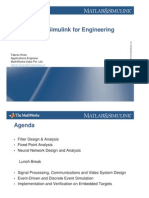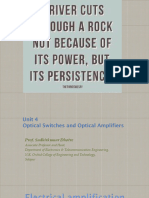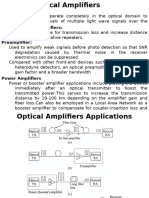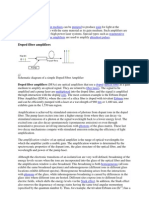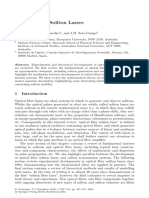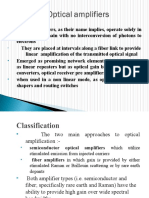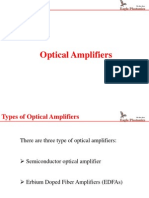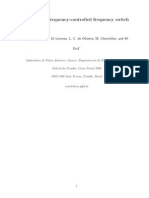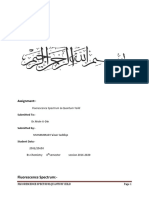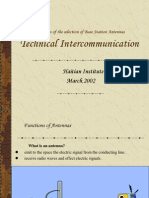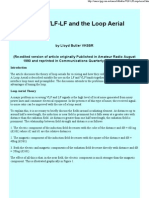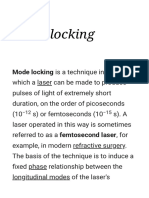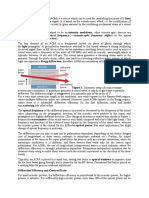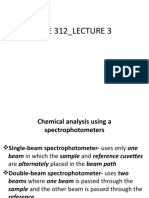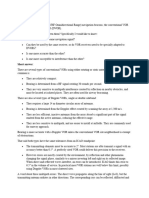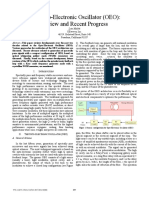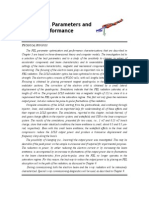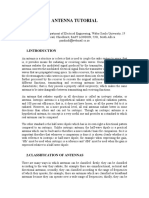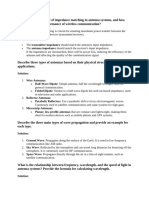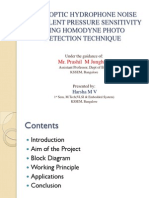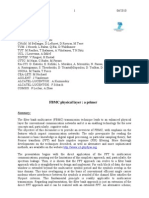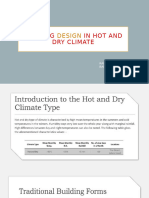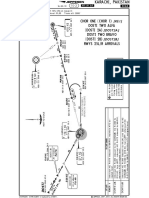Optical Parametric Oscillators
Optical Parametric Oscillators
Uploaded by
Chinmayee MishraCopyright:
Available Formats
Optical Parametric Oscillators
Optical Parametric Oscillators
Uploaded by
Chinmayee MishraOriginal Description:
Copyright
Available Formats
Share this document
Did you find this document useful?
Is this content inappropriate?
Copyright:
Available Formats
Optical Parametric Oscillators
Optical Parametric Oscillators
Uploaded by
Chinmayee MishraCopyright:
Available Formats
An Introduction to Optical Parametric Oscillators
Unlike a tunable laser, which employs various energy strategies to deliver relatively broad coverage, an optical parametric oscillator (OPO), in a process similar to harmonic generation, relies on the nonlinear response of a medium to a driving field (the pump laser beam) to convert photons of one wavelength to photons of other, longer wavelengths. Specifically, in the parametric process, a nonlinear medium (usually a crystal) converts the high energy photon (the pump wave) into two lower energy photons (the signal and idler waves).
Signal and Idler Beam Generated in a Non-Linear Crystal Energy conversion requires that the three photons be related as follows:
or in terms of photon energy, pump energy = signal energy + idler energy The exact wavelengths of the signal and idler are determined by the angle the pump wave vector makes with respect to the crystal axis. Energy can be transferred efficiently to the parametric waves if all three waves are traveling at the same velocity. Under most circumstances, the variation of index of refraction with crystal angle and wavelength allows this "phase matching" condition to be met only for a single set of wavelengths for a given crystal angle and pump wavelength. Thus as the crystal rotates, different wavelengths of light are produced. When the crystal is contained in a resonant cavity, feedback causes gain in the parametric waves in a process similar to buildup in a laser cavity. Thus, light output at the resonated wavelength (and the simultaneously produced other parametric wavelength) occurs. The cavity can either be singly resonant at either the signal or idler wavelength, or it can be doubly resonant at both wavelengths. A simple OPO will exhibit a relatively broad bandwidth (about 15 cm-1) determined by the bandwidth acceptance of the nonlinear crystal. Introducing frequency selective elements into the cavity helps reduce bandwidth. Additional parametric stages may amplify the beam further. These stages may be resonant or nonresonant. An advantage of optical parametric amplifiers (OPA) over ordinary amplifiers is OPA can also provide additional conversion. Seeding an OPA with either the signal or idler wavelength results not only in amplification at that wavelength, but also at the accompanying wavelength. And pumping the OPA with a frequency different from the OPO pump extends the wavelength range of an oscillator. When amplifying low energy pulses from a narrowband oscillator, an OPA produces higher energy while maintaining the fidelity of the oscillator's narrow bandwidth. Varying OPA configurations produce outputs which span the wavelength range of interest.
For further reading, please see the following: Solid State Laser Engineering, 3rd edition, Walter Koechner, ed., Springer Verlag, Berlin, 1992 Improving High Power OPO Performance, M. B. Radunsky, Laser Focus World, p.107, October 1995 Spectroscopic Applications of Pulsed Tunable Parametric Oscillators, B. J. Orr et. al., in Tunable Laser Applications, F. J. Duarte, ed., Marcel Deckker, 1995
You might also like
- Presentation ISO IEC 17021-1Document23 pagesPresentation ISO IEC 17021-1Ganesh Natarajan100% (1)
- To Determine Manning's Coefficient and Chezy Coefficient of Laboratory FlumeDocument3 pagesTo Determine Manning's Coefficient and Chezy Coefficient of Laboratory FlumeRahat Usman0% (1)
- MATLAB Simulink For Engineering EducationDocument32 pagesMATLAB Simulink For Engineering EducationKalyan GovindarajanNo ratings yet
- 4 - 2 Optical AmplifiersDocument55 pages4 - 2 Optical AmplifiersSudip MaliNo ratings yet
- Module 4 - Optical AmpDocument39 pagesModule 4 - Optical Ampchrisbinsony80No ratings yet
- Optical BasicsDocument22 pagesOptical BasicsBanoth VinodNo ratings yet
- Laser AmplifiersDocument4 pagesLaser AmplifiersdineshkattaNo ratings yet
- G Town - Optical - Fiber - Soliton - LasersDocument33 pagesG Town - Optical - Fiber - Soliton - Lasersmário ferreiraNo ratings yet
- Nonlinear Optics (NLO) ApplicationsDocument3 pagesNonlinear Optics (NLO) ApplicationsSaranya SNo ratings yet
- Optical AmplifiersDocument30 pagesOptical AmplifiersVishnu dasNo ratings yet
- Characterization of Optical FibersDocument17 pagesCharacterization of Optical Fibersneha gargNo ratings yet
- Optical AmplifiersDocument34 pagesOptical Amplifierspriyasingh1682No ratings yet
- Erbium-Doped Amplifiers:: FibreDocument10 pagesErbium-Doped Amplifiers:: FibreVictor Alfonso Gomez MatallanaNo ratings yet
- Optical SourcesDocument30 pagesOptical Sourcesomar.alamodiNo ratings yet
- Switch Sorrentino 2010Document21 pagesSwitch Sorrentino 2010kepler123No ratings yet
- Fiber Optics - 4 - Copy-1 PDFDocument40 pagesFiber Optics - 4 - Copy-1 PDFanishaantexNo ratings yet
- Optica Articulo 1Document5 pagesOptica Articulo 1james3030No ratings yet
- Optical Amplification, Wavelength Conversion and RegenerationDocument15 pagesOptical Amplification, Wavelength Conversion and Regenerationfatimah.albadiri.ms9No ratings yet
- Unit 9 - Optical AmplifierDocument55 pagesUnit 9 - Optical Amplifiervidyasawant2012No ratings yet
- Optical Phase Conjugation Technique Using Four-Wave Mixing in Semiconductor Optical AmplifierDocument2 pagesOptical Phase Conjugation Technique Using Four-Wave Mixing in Semiconductor Optical AmplifierDang ShinichiNo ratings yet
- Tutorial ProblemsDocument11 pagesTutorial ProblemsMani VrsNo ratings yet
- Aom GuideDocument10 pagesAom GuidesncamieNo ratings yet
- Full Report of Mini ProjectDocument23 pagesFull Report of Mini ProjectNarsyida Niasara HamdanNo ratings yet
- Solved Prob. chp1 3rd YearDocument16 pagesSolved Prob. chp1 3rd Yearalifadhil989898No ratings yet
- 2009 Advanced Optical Limiting FunctionDocument4 pages2009 Advanced Optical Limiting FunctionAmiroucheNo ratings yet
- Antenna TheoryDocument65 pagesAntenna TheoryÅpûrbǻ ßìswåsNo ratings yet
- Lecture: Erbium Doped Fiber Amplifiers (Edfa)Document11 pagesLecture: Erbium Doped Fiber Amplifiers (Edfa)aliflailasurumiNo ratings yet
- Assignment:-: Fluorescence SpectrumDocument14 pagesAssignment:-: Fluorescence SpectrumMuhammad FaizanNo ratings yet
- A Laboratory Manual Of: Antenna & Wave PropagationDocument29 pagesA Laboratory Manual Of: Antenna & Wave PropagationRommy PasvanNo ratings yet
- Niedereder Tera HZ Technology PDFDocument13 pagesNiedereder Tera HZ Technology PDFlazarosNo ratings yet
- LC OscillatorsDocument19 pagesLC OscillatorsOlivier ErnstNo ratings yet
- Ant TheoryDocument45 pagesAnt TheoryAbood AliNo ratings yet
- Chapter-1 Optical Fiber CommunicationDocument24 pagesChapter-1 Optical Fiber CommunicationAkhil GargNo ratings yet
- Antenna PrimerDocument102 pagesAntenna PrimerWaqar AhmadNo ratings yet
- Yagi-Uda Antenna Radio Electromagnetic WavesDocument12 pagesYagi-Uda Antenna Radio Electromagnetic WavesAtif HaiderNo ratings yet
- MisurareDocument8 pagesMisurareiw4blgNo ratings yet
- Mode Locking - WikipediaDocument47 pagesMode Locking - WikipediaNaveed SialNo ratings yet
- Dipole AnntennaDocument7 pagesDipole AnntennaharithmaggedNo ratings yet
- Fluorescence SpectrosDocument5 pagesFluorescence SpectrosrutwickNo ratings yet
- Acousto Optic EffectDocument4 pagesAcousto Optic EffectJashan BansalNo ratings yet
- Ofc Module - 03Document7 pagesOfc Module - 03shameem v.pNo ratings yet
- Measurement of Antenna Radiation Patterns: Laboratory ManualDocument44 pagesMeasurement of Antenna Radiation Patterns: Laboratory ManualMoBilbeisiNo ratings yet
- CHE 312 Lecture 3 - 2023Document44 pagesCHE 312 Lecture 3 - 2023Oná Lé ThataNo ratings yet
- DEVANSH1Document22 pagesDEVANSH1Anonymous JbTrVPjpNo ratings yet
- Cvor DvorDocument21 pagesCvor DvorMinh Trí Nguyễn (Minh Kio)No ratings yet
- Optical SpectrosDocument7 pagesOptical SpectrosgayaxniNo ratings yet
- The Opto-Electronic Oscillator (OEO) : Review and Recent ProgressDocument4 pagesThe Opto-Electronic Oscillator (OEO) : Review and Recent ProgressDuong Ly HoangNo ratings yet
- R, R + S I N 0: Target-Reflection Characteristics and AngularDocument2 pagesR, R + S I N 0: Target-Reflection Characteristics and Angularanjali9myneniNo ratings yet
- FEL Parameters and Performance: Echnical YnopsisDocument30 pagesFEL Parameters and Performance: Echnical Ynopsisuser_14No ratings yet
- Small Antennas For High FrequenciesDocument23 pagesSmall Antennas For High FrequenciesGumaMohamedNo ratings yet
- Properties of Light:: SearchDocument8 pagesProperties of Light:: SearchdkishoreNo ratings yet
- C&S LoopDocument6 pagesC&S LooputammarryNo ratings yet
- Antenna TutorialDocument42 pagesAntenna TutorialNestor Alberto Escala100% (1)
- Short-Pulse Generation in Interferometers Employing Semiconductor Optical AmplifiersDocument11 pagesShort-Pulse Generation in Interferometers Employing Semiconductor Optical AmplifiersarsayyadiNo ratings yet
- Transmission Media AntennaDocument7 pagesTransmission Media AntennanadunichathushikaNo ratings yet
- Q and a for Antenna TheoryDocument4 pagesQ and a for Antenna TheoryDare OluwabukolaNo ratings yet
- Fiber Optic Hydrophone Noise Equivalent Pressure Sensitivity Using Homodyne Photo Detection TechniqueDocument22 pagesFiber Optic Hydrophone Noise Equivalent Pressure Sensitivity Using Homodyne Photo Detection TechniqueHarsha M VNo ratings yet
- مختبر هوائياتDocument7 pagesمختبر هوائيات0e8fd1d8beNo ratings yet
- Antennas 101 5ppDocument5 pagesAntennas 101 5ppj.emmett.dwyer1033No ratings yet
- Amateur Radio Electronics on Your MobileFrom EverandAmateur Radio Electronics on Your MobileRating: 5 out of 5 stars5/5 (1)
- Environmental Health & Safety: Oklahoma State UniversityDocument16 pagesEnvironmental Health & Safety: Oklahoma State UniversityMarienNo ratings yet
- Descon Internship ReportDocument73 pagesDescon Internship ReportExcelent ProjectsNo ratings yet
- Molding English Vs Chinese ListDocument2 pagesMolding English Vs Chinese Listindex19761011No ratings yet
- Issue Resolution & Escalation Training PackDocument56 pagesIssue Resolution & Escalation Training PackTuan AnhNo ratings yet
- Solved - HP CLJ CM4730 MFP 30.01.34 Scanner Failure - HP Support Community - 5064328Document1 pageSolved - HP CLJ CM4730 MFP 30.01.34 Scanner Failure - HP Support Community - 5064328johnnevesNo ratings yet
- Inspiron 15r Se 7520 Owner's Manual UsDocument84 pagesInspiron 15r Se 7520 Owner's Manual UsANo ratings yet
- Aero 8000 H-PCDocument34 pagesAero 8000 H-PCscribdermaniacNo ratings yet
- DatasheetDocument11 pagesDatasheetrafhenNo ratings yet
- E-Bike Seminar ReportDocument22 pagesE-Bike Seminar ReportArjun Pawase100% (2)
- Ogp 434-01Document42 pagesOgp 434-01Kishore ReddyNo ratings yet
- Sony SLV-ED15-ED25-ED33-EDXX.....Document79 pagesSony SLV-ED15-ED25-ED33-EDXX.....videosonNo ratings yet
- The Netherlands: PAGE 1/10 For The Used Components and Serial Number See Attached "List of Specification"Document75 pagesThe Netherlands: PAGE 1/10 For The Used Components and Serial Number See Attached "List of Specification"Pedro HenriqueNo ratings yet
- FBMC Primer 06 2010Document31 pagesFBMC Primer 06 2010aladnaniNo ratings yet
- Shift Lock InspectionDocument2 pagesShift Lock InspectionRomeo HinogNo ratings yet
- 3p In-3p Out Solar Inverter Specification DetailDocument1 page3p In-3p Out Solar Inverter Specification DetailRaman GargNo ratings yet
- Journal King SaudDocument11 pagesJournal King SaudgasibuteaNo ratings yet
- ADV1594BU FORMATTED FINAL 1507829874065001ITMvDocument53 pagesADV1594BU FORMATTED FINAL 1507829874065001ITMvscribd!!No ratings yet
- Sheet 4 ME312Document5 pagesSheet 4 ME312Tito HeshamNo ratings yet
- 6300 CatalogDocument15 pages6300 CatalogMarco MinariniNo ratings yet
- Building Design in Hot and Dry ClimateDocument11 pagesBuilding Design in Hot and Dry ClimateRaheel RajputNo ratings yet
- Basics of Digital Signatures and PKI SDocument4 pagesBasics of Digital Signatures and PKI SPramedicaPerdanaPutraNo ratings yet
- Lecture-1-2 (Basics of HCI)Document32 pagesLecture-1-2 (Basics of HCI)naziaNo ratings yet
- OPKC Approach PlatesDocument20 pagesOPKC Approach PlatesSan Khan100% (1)
- Ubicc Dwmsn-Ems 466Document7 pagesUbicc Dwmsn-Ems 466Ubiquitous Computing and Communication JournalNo ratings yet
- Series 6000 - StructuresDocument78 pagesSeries 6000 - StructuresBatenda Felix100% (1)
- Types of Fire Extinguishers PDFDocument25 pagesTypes of Fire Extinguishers PDFRiyan SyedNo ratings yet
- Lecture 17Document2 pagesLecture 17amrah2No ratings yet


